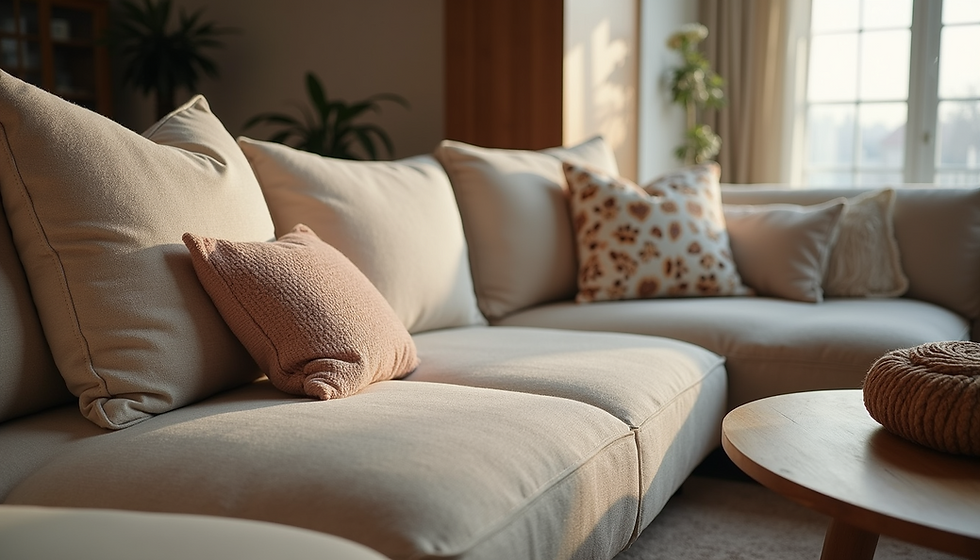Retro Room Design
- Jayant Upadhyay
- Jun 26
- 4 min read
Updated: Jun 28

Retro room design is a celebration of bold colors, eclectic patterns, and nostalgic furnishings that harken back to some of the most vibrant decades of interior design. From the sleek lines of the 1950s to the groovy vibe of the 1970s and the playful palette of the 1980s, retro design isn’t about replicating the past exactly but capturing its spirit with a modern sensibility.
In this 2000-word guide, we’ll explore how to design a retro-inspired room that balances vintage charm with contemporary comfort. We’ll cover essential color palettes, furniture choices, lighting, accessories, and styling tips that help you embrace retro aesthetics in any room of your home.
1. What is Retro Design?
Retro design refers to interior styles from the mid-20th century, particularly the 1950s, 60s, 70s, and 80s. It emphasizes fun, optimism, and experimentation. Think of avocado green appliances, sunburst clocks, shag rugs, and plastic chairs.
Key Characteristics:
Bold and contrasting colors
Geometric and psychedelic patterns
Curved furniture with a futuristic feel
Funky lighting fixtures
Mix of materials like wood, metal, plastic, and vinyl
2. Choosing the Right Era
Each retro decade offers its own flavor:
1950s: Clean lines, pastel colors, chrome accents, diner-style furniture
1960s: Pop art, bold prints, futuristic designs, lava lamps
1970s: Earthy tones, boho elements, wood paneling, shag carpets
1980s: Neon lights, Memphis design, glass blocks, graphic prints
Choose an era that resonates with your style or combine influences from multiple decades for a curated retro-modern fusion.
3. Color Palettes That Pop
Color plays a crucial role in retro room design. Retro palettes can range from muted tones to highly saturated hues depending on the decade.
Popular Retro Colors:
Mustard yellow
Burnt orange
Olive green
Teal blue
Bubblegum pink
Cherry red
Turquoise
Combine these with neutral backgrounds like cream or beige to balance the look. Or go bold with wall-to-wall color if you’re feeling adventurous.
Pro Tip:
If you're hesitant about bold colors, start small with accent pieces like throw pillows, art, or a colorful chair.
4. Retro Furniture Essentials
Furniture is the foundation of your retro room. Look for pieces with character—something that speaks to the era.
1950s-Style Furniture:
Mid-century modern sofas with wooden legs
Formica kitchen tables
Eames lounge chairs
1960s Furniture:
Pod chairs
Plastic modular shelving
Tulip tables
1970s Furniture:
Low-profile sofas
Bean bag chairs
Macrame wall hangings
1980s Furniture:
Bold, sculptural forms
Lacquered surfaces
Chrome and glass coffee tables
Blending one or two iconic pieces into a modern setup can create a great visual contrast without overwhelming the space.
5. Retro Patterns and Textures
Textures and patterns help define the room’s character. The retro era is known for geometric motifs, stripes, polka dots, and psychedelic swirls.
Materials to Consider:
Velvet and corduroy upholstery
Shag rugs and plush carpets
Vinyl seating and leatherette
Wood veneer and paneling
Use wallpaper for a statement wall or bring patterns in through curtains, rugs, and pillows.
6. Lighting: The Funk Factor
Retro lighting is often quirky and eye-catching. Choose lighting that enhances the overall theme of the room.
Lighting Ideas:
Sputnik chandeliers (50s/60s)
Lava lamps (60s/70s)
Arc floor lamps (70s)
Neon signs (80s)
Globe pendant lights
Mix floor lamps with pendant lights and table lamps to create a layered lighting plan.
7. Wall Art and Decor Accents
Accessories are the easiest way to build a retro vibe without permanent changes.
Ideas:
Vintage posters and record album covers
Pop art and abstract paintings
Clocks with atomic or sunburst designs
Retro mirrors with funky frames
Group artwork in gallery-style clusters or use one large statement piece.
8. Flooring Options for Retro Rooms
Flooring can subtly support your retro theme.
Options:
Checkerboard tile for a 50s diner feel
Shag rugs for a 70s vibe
Wall-to-wall carpet in muted colors (popular in 70s and 80s)
Wood or laminate flooring with area rugs
Rugs with abstract or geometric designs are a great compromise for modern homes.
9. Retro Kitchen and Dining Ideas
Want to extend the retro look into your kitchen?
Tips:
Use pastel or bold-colored appliances
Include chrome bar stools and counters
Display vintage dishware on open shelves
Use diner-style booths for seating
In the dining room, consider tulip tables or retro pedestal tables with matching colorful chairs.
10. Bedroom and Bathroom Retro Touches
For the bedroom, retro design can be cozy and cool.
Bedroom Decor:
Platform beds with tufted headboards
Bold patterned wallpaper
Mirrored vanities or acrylic dressers
Pendant lighting or vintage sconces
Bathroom Ideas:
Colored tile (mint, peach, aqua)
Funky printed shower curtains
Globe vanity lights
Vintage-style hardware and mirrors
11. Where to Shop for Retro Pieces
You can find great retro furniture and decor at:
Vintage stores
Online marketplaces (Etsy, eBay)
Thrift shops and estate sales
Reproduction stores specializing in mid-century modern
Look for items labeled "mid-century modern," "mod," "atomic age," or "vintage 70s/80s."
12. Mixing Retro with Modern
Retro design doesn’t mean living in a time capsule. Blending old with new can result in a space that feels nostalgic yet fresh.
Balancing Act:
Use retro furniture with modern lighting
Add contemporary art to retro spaces
Use modern tech discreetly (hide wires, choose minimal devices)
13. Final Styling Tips
To complete your retro room design:
Keep the color palette consistent
Don’t over-accessorize; let statement pieces shine
Incorporate plants like snake plants or spider plants in vintage planters
Use record players, rotary phones, or retro radios as decorative elements
Conclusion
Retro room design offers a fun and expressive way to decorate your home. Whether you go all-in with a 1970s-style living room or just add a few retro touches to your modern apartment, the key is to keep it personal and intentional. Choose elements that bring joy, spark nostalgia, or start conversations. With thoughtful integration, your space can reflect the best of the past while comfortably existing in the present.
Remember: Retro isn’t about living in the past—it’s about making the past stylish again.



Comments